Some people completely shy away from direct ab exercises, either out of boredom or because they believe the big compound exercises like squats and overhead presses work their abs enough. But plenty of other lifters make ab training a priority, be it to improve performance or their physique. When it comes to a good-looking set … Read more
The post How to Do the Reverse Crunch for Strong, Well-Developed Abs appeared first on Breaking Muscle.
Some people completely shy away from direct ab exercises, either out of boredom or because they believe the big compound exercises like squats and overhead presses work their abs enough. But plenty of other lifters make ab training a priority, be it to improve performance or their physique.
When it comes to a good-looking set of abs, lower ab development is especially coveted. Exercises that involve leg movement, such as various leg lifts or the simple reverse crunch, are commonly used to target this area. Is it a valid strategy? Maybe, as you’ll soon learn.

In any case, the reverse crunch is a simple and effective exercise to build and strengthen your abs, improve spine stabilization, and become a fitter, more muscular human being. For many, it’s the first “leg raising” exercise learned, so it’s time you know how to do it properly and reap its benefits.
- How to Do the Reverse Crunch
- Reverse Crunch Mistakes to Avoid
- Benefits of the Reverse Crunch
- Muscles Worked by the Reverse Crunch
- Who Should Do the Reverse Crunch
- How to Program the Reverse Crunch
- Reverse Crunch Variations
- Reverse Crunch Alternatives
- Frequently Asked Questions
How to Do the Reverse Crunch
Even though it’s a beginner-friendly exercise, you have to ensure proper form if you want maximal efficiency while avoiding pain. The reverse crunch is slightly more complex than a traditional crunch because it involves leg movement, torso flexion, as well as spinal control. Here’s how to do it right.
Step 1 — Lie Down in Position
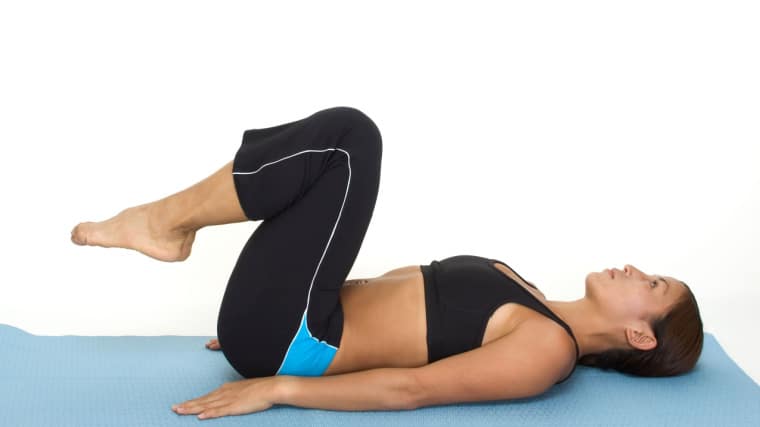
No need for equipment — except for a gym mat if you need some comfort. Simply lie down on the floor. Keep your upper body completely flat, squeeze your glutes, and tilt your pelvis backwards to push your lower back into the ground. This will prevent your lower back from arching at any point during the lift.
Place your arms on the floor by your side, palms down, and use them for balance. Bend your legs and set your feet flat on the ground.
Form tip: If you have trouble keeping your lower back flat, lift your shoulder blades slightly off the ground. This will help you create more tension in your abs and provide more control over your spine and hips. Having an arched back reduces your ability to contract your abs.
Step 2 — Bring Your Knees Toward Your Head
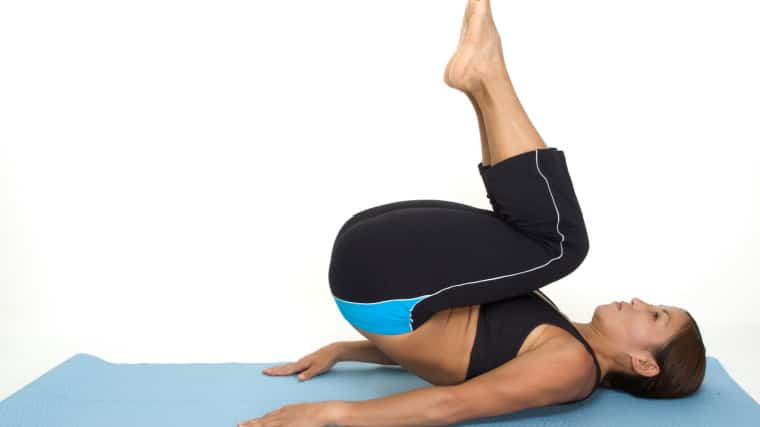
Take a breath into your belly and brace your abs. Tuck your legs towards your face until your hips and lower back lift from the ground. As your legs move, maintain a roughly 90-degree angle at your knees.
No other movement should occur in your body: keep your legs at the same angle, brace as much as you can, and drive your hands into the ground to stabilize yourself. Go slow so that you don’t risk losing posture. In the top position, your hips should be off the ground for maximum ab recruitment.
Form tip: If you want to make the exercise harder, straighten your legs as you begin the movement or after you’ve reached the top position. This creates a longer lever arm and increases the challenge on your core muscles.
Step 3 — Lower Your Legs With Control
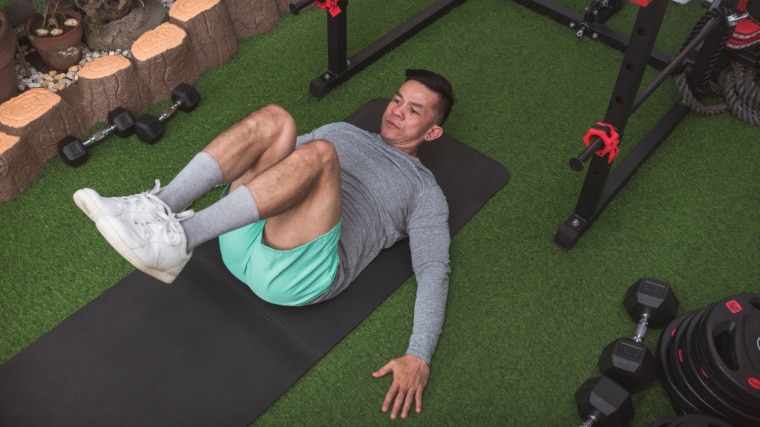
Lower your legs slowly until your feet touch the ground and you’ve returned to the starting position. Moving at a relatively slower speed helps you feel your abs working and eliminates momentum.
To keep tension in your core, don’t allow your lower back to arch as you bring your legs down. Keep your pelvis tilted backwards and your lower back pushed into the ground throughout the entire repetition.
Form tip: If your back begins to arch as your legs move, bend your legs more. Shortening the range of motion can also help. Until you have enough total-core control, only lower your legs until you feel your back starting to arch, and then reverse the movement.
Reverse Crunch Mistakes to Avoid
Ab exercises that incorporate leg movement are prone to bad form because many people lose focus. Even though the reverse crunch is probably the simplest leg raise-type of exercise, mistakes are still frequent.
Arching Your Lower Back
This is a frequent mistake with beginners, because many new lifters lack spinal control and core strength. Arching your lower back will decrease ab involvement and shift more of the workload towards the hip flexors.
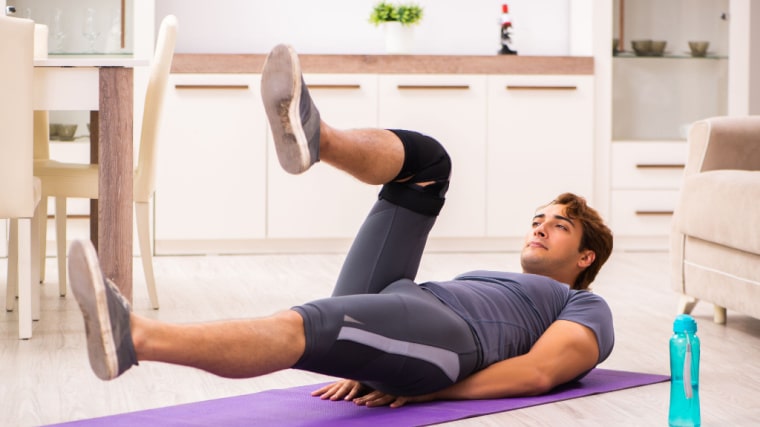
Is it a bad thing? Well, if you want better-looking abs, it won’t be as efficient. More importantly, this can cause stress on the lower back region. If you want to avoid pain and potential injuries, aim to minimize lower back arching and hip flexor involvement. (1)
Avoid it: Make sure your core is always braced and under tension. When you’re not flexing your trunk, make sure your lower back is firmly in contact with the ground. Do the exercise slowly and with control. Slightly elevate your shoulder blades from the floor to further engage your core, if needed.
Using Momentum
It can be tempting to allow momentum to take over because it makes the exercise easier, but it will greatly diminish muscle activation. If you start swinging your legs around, you’ll end up using mostly your hip flexors in lieu of your abs, and you risk arching your lower back during the eccentric (descent).
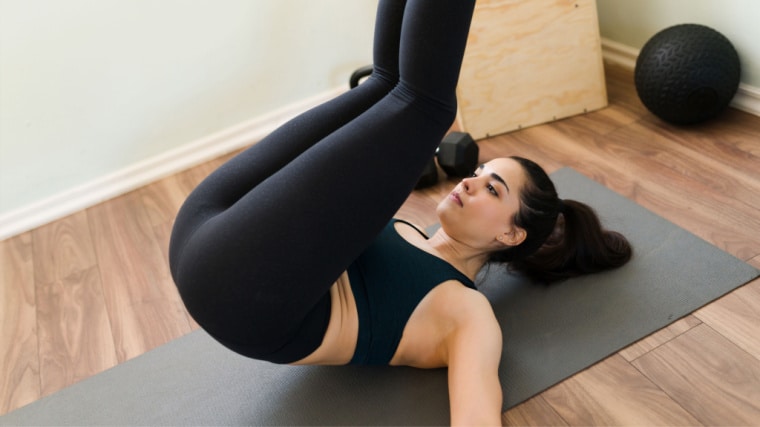
If you’re aiming for muscle growth, this is inefficient as it will also reduce time under tension and you’ll have to perform many more repetitions, and spend more time and overall effort, just to have the same stimulus as a strict movement. (2) This can also put more strain on your hip joints and lower back, possibly resulting in pain or injuries.
Avoid it: There is a certain execution speed at which your body will lose muscle tension and optimal bracing. You should never reach that speed but, unfortunately, you only know it once you reach it. If you’re not sure, simply use a slow tempo — two to three seconds on the concentric (lifting) and two to three seconds for the eccentric (lowering).
Benefits of the Reverse Crunch
The simplest exercises are often the most efficient, and the reverse crunch is no exception. Learn how this lift can improve your fitness and provide benefits that other ab exercises lack.
Abdominal Muscle Growth
They say that “abs are made in the kitchen,” but they are actually made in the gym. A balanced diet and a healthy body fat will only reveal them, but if you want to display an impressive set of abs, you have to train them like any other muscle.
A properly executed reverse crunch will offer significant time under tension and provide a different stimulus than what your abs are used to if you’ve only been doing standard crunches or sit-ups. Incorporating the movement for variety will also help build more muscle. (3)
Core Strength
This exercise will improve ab strength and boost your core and bracing abilities. The reverse crunch teaches you how to transfer energy from your your core to other limbs (your legs, specifically). You also learn how to brace properly for maximum efficiency and strength.
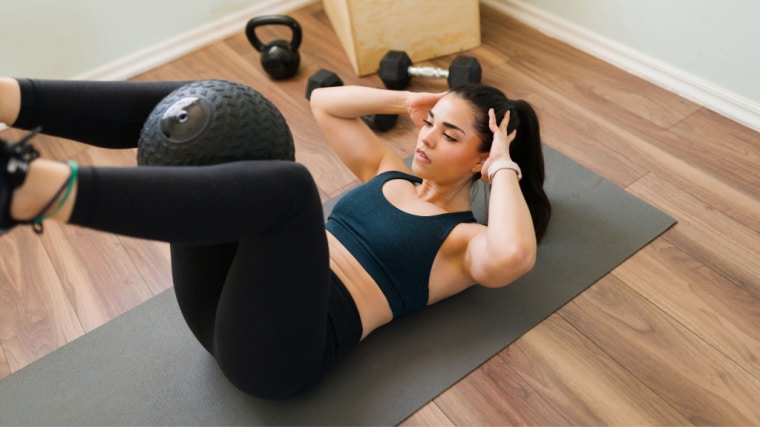
The general principle is similar to squatting, where your core helps you transfer the energy from your legs through your core and into the barbell. The reverse crunch can help you get better at compound exercises which require core stability, making you a stronger and more complete lifter.
Spinal Control
The hard part of the exercise is actually to exert proper ab tension while bracing enough to prevent your lower back from arching. Maintaining this strong position will teach you how to stabilize your spine and efficiently brace your core. Improved spinal stability and control can reduce your risk of lower back pain and injuries, and improve your total-body strength. (4)(5)
Muscles Worked by the Reverse Crunch
The reverse crunch is a trunk flexion exercise, which means that it will mainly target the rectus abdominis, but most of the core will actually contribute. Ab exercises which incorporate leg movement are said to emphasize lower-ab development. Let’s see if that’s true and what muscles it trains.
Rectus Abdominis
This is the famous “six pack.” It’s the most visible ab muscle and goes from the pelvis to the sternum. The main function of the rectus abdominis is to flex the trunk by bringing the ribs and the pelvis closer together.
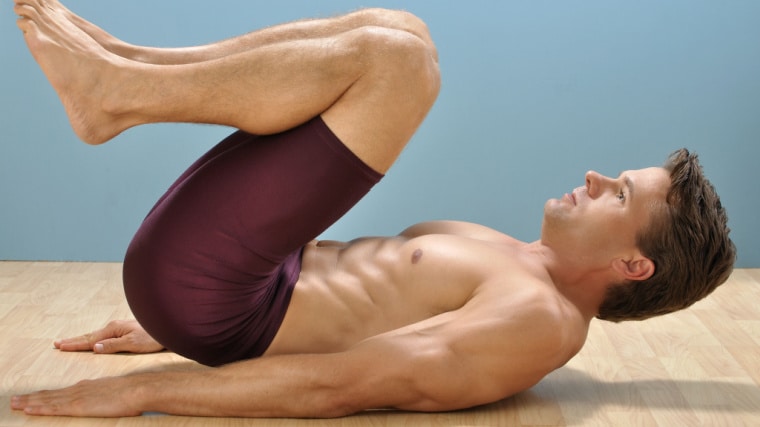
Now, here’s the tricky part: It is often claimed that you can “target” the upper or lower sections of the muscle. Typically, ab exercises which bring the ribs closer to the pelvis are considered “upper ab exercises.” Movements which bring the pelvis closer to the ribs, like the reverse crunch, are thought to be “lower ab exercises.”
However, the rectus abdominis is still one single muscle (with multiple tendons running across it) so it is always fully contracted. Is it really possible to emphasize the lower separate from the upper? Let’s look at the research.
One study didn’t find a significant difference between exercises in terms of upper or lower ab recruitment. (6) But the exercises were performed with the lifters’ hands under their lower back, which might have caused less lower abs involvement by increasing the back arch.
Comparatively, some studies have found a difference in activation. (7) If the hips are flexed towards the ribs while the upper body remains stationary, the lower abs have been shown to do more work.
So it seems that recruiting the lower abs is highly related to exercise selection. You cannot “isolate” the upper or the lower abs — the rectus abdominis will always work as a whole — but some movements can stress either section slightly more. Properly performed exercises that contract the abdominals by rotating your pelvis closer to your (stationary) ribcage may emphasize the lower abs more than the upper. (8)
Obliques
The internal and external obliques are the “side abs” going from your hip bones up towards your ribs. They are significantly recruited when twisting from the waist or bending sideways.
The obliques are also slightly involved in flexing the trunk, and they work heavily to prevent the body from bending or twisting. They are recruited, particularly in the top portion of the reverse crunch, to stabilize your lower body as it raises slightly into the air.
Hip Flexors
The hip flexors are a series of muscles responsible for bringing the leg up towards the body. These relatively small but powerful muscles are involved in the reverse crunch because of the leg movement. They are particularly activated as your legs are lowered to the ground and raised from it.
If you fail to lift your pelvis towards your torso in the top part of each repetition, the hip flexors (and not the abdominals) will be the primary muscles worked during the reverse crunch.
Who Should Do the Reverse Crunch
Ab exercises can be useful to virtually anyone, so you should likely include some direct ab exercises in your training. Here’s when the reverse crunch, specifically, is most beneficial.
People Who Want to Look Good
If you want to sport an aesthetic physique, then you need to do some direct ab work. One psychology study even revealed that well-developed abdominals are the most desirable body part for men, and in the top three for women. (9)
If you want your upper body to be pleasing to the eye, then including reverse crunches as part of your training will go a long way, especially when paired with a specific fat loss diet and an overall well-muscled physique.
Strength Athletes
Many strength lifts such as squats, deadlifts, or presses require a strong core to support moving the heaviest weights possible. The reverse crunch can help by developing the muscles responsible for increasing intra-abdominal pressure, improving spinal control and stability, and increasing bracing abilities. A stronger core is shown to help make you stronger as a whole. (10)
Sports Athletes
In the same fashion, core strength will help you develop more speed and power if you’re a general sports athlete. (11) We rarely think of it, but running, jumping, and throwing all require core strength and total-body coordination. Moreover, the reverse crunch strengthens the hip flexors, which will are heavily involved in running, jumping, and agility.
People with Back Issues
If you’ve experienced back pain, or want to prevent it, strengthening your abs is just as important as strengthening your lower back. The body needs balance in order to perform optimally. Unfortunately, modern life often leads to muscular imbalances, poor posture, and a lack of general physical condition. The reverse crunch can help you combat these potential lower back issues by improving core strength. (12)
How to Program the Reverse Crunch
As a basic bodyweight exercise, the reverse crunch is quite straightforward to program. You can also add some resistance to spice things up a bit. Adopt these repetition schemes if you want maximal benefit, instead of doing countless low-effort reps.
Unweighted, Moderate to High Reps
This is a common range for ab exercises. Three to four sets of 10 to 20 repetitions with 30 to 60 seconds of rest will do the trick, provided you use perfect form. If you can bang out an ultra-high number of reps, it’s an indicator that you’re using improper form or you’re a beast that needs to add some resistance.
Weighted, Moderate Reps
You can either secure a small weight plate on your ankles and shins or hold a dumbbell or medicine ball between your feet. A load that’s difficult for three to four sets of six to 12 repetitions will provide an increased challenge to build strength or stimulate new growth. It’s essential to keep your form the same or it will defeat the purpose of the exercise.
Reverse Crunch Variations
Perhaps you’ve had enough of lying on the ground or you want to stimulate your abs and hip flexors in a new fashion. Here are some kickass variations that will share the same benefits as the reverse crunch and focus on your lower abs.
Hanging Leg Raise
Hang from a pull-up bar, hanging knee raise station, or Roman chair. To really recruit your abs and not focus on your hip flexors, be sure to curl your pelvis up toward your chest at the top of the movement.
This is an efficient movement because it can easily be scaled down, by bending the legs, or scaled up by aiming to touch your feet to the bar over your head. Moreover, the hanging version will also “decompress” your spine, providing comfortable relief after an intense pulling workout or leg day.
V-Up
This is a relatively advanced bodyweight exercise, but if you’ve mastered the reverse crunch, this can be a progression instead of adding resistance. The v-up is one of the most powerful movements to improve core bracing because it requires a high level of abdominal tension combined with leg and arm movement.
The exercise will teach you to transfer energy efficiently between your limbs, as well as provide a serious workout for the abs, hip flexors, and even the serratus — a key muscle for shoulder stability and performance.
Lying Leg Raise
This is the reverse crunch’s almost-identical twin brother. It appears similar, but subtle differences offer unique benefits. The lying leg raise only involves leg movement without raising the pelvis or hips, so it will focus more on recruiting the hip flexors.
However, as long as you prevent any lower back arching, your abs will get a serious workout as well. The overall technique is less complicated, making it is relatively simpler than the reverse crunch.
Reverse Crunch Alternatives
What if you want to train your abs while emphasizing the upper part? Don’t worry, you’re covered with these alternatives.
Crunch
The direct opposite of the reverse crunch. The good ol’ crunch is often butchered because the range of motion is so short, but when done correctly, it can be a fantastic ab exercise.
Because it only involves upper trunk flexion, this exercise will torch your upper abs. The basic crunch is possibly one of the most simple and effective ways to train the abs.
Cable Crunch
This exercise is favored for its simplicity and for how convenient it is to add potentially heavy resistance. The cable crunch is the bread and butter for any lifter who wants to build a powerful core.
The cable crunch is one of the best ways to develop stronger, bigger abs through progressive overload. A properly done cable crunch will result in superior upper abs recruitment with little to no hip flexor involvement.
Sit-up
The sit-up is the quintessential ab exercise found in many professional and athletic physical fitness tests. It’s highly efficient for building, and assessing, total core strength and development.
Like all crunch variations, you can easily add external resistance with a weight plate or weighted vest, but many lifters find the properly performed sit-up to be relatively challenging due to the long range of motion.
FAQs
Should I do the reverse crunch at the start or at the end of a workout?
Both can be valid tactics. Training abs at the end of a workout is the traditional way to go, and for good reason. By finishing with ab work, your core won’t be as fatigued during the session when you want to be fresh for heavier exercises, like squats.
But if you’re someone that loathes training abs, doing them first will ensure that you don’t skip them because you’re “too tired” after an exhausting workout. You probably won’t be as strong during the first few sessions, but you’ll likely adapt and benefit in the long-run.
Will the reverse crunch shred my abs?
Unfortunately, no. This exercise will strengthen your abs and stimulate muscle growth, so they can look better, but you have to be able to see them first. The only thing that will reveal your abs is to achieve a low enough body fat percentage.
For that, you need to check your energy expenditure and be in a caloric deficit long enough so that you melt your belly and reveal your six-pack. You can consume less calories, and/or burn more calories through physical activities or cardio.
Reverse Engineer Your Way to a Great Set of Abs
Incorporating the reverse crunch in your training regimen doesn’t just deliver a better looking six-pack. It’s an overlooked way to build a stronger and healthier core. It’s time to stop avoiding ab work, get on the floor, and get those knees up.
References
-
Avrahami, D., & Potvin, J. R. (2014). The clinical and biomechanical effects of fascial-muscular lengthening therapy on tight hip flexor patients with and without low back pain. The Journal of the Canadian Chiropractic Association, 58(4), 444–455.
-
Burd NA, Andrews RJ, West DW, Little JP, Cochran AJ, Hector AJ, Cashaback JG, Gibala MJ, Potvin JR, Baker SK, Phillips SM. Muscle time under tension during resistance exercise stimulates differential muscle protein sub-fractional synthetic responses in men. J Physiol. 2012 Jan 15;590(2):351-62. doi: 10.1113/jphysiol.2011.221200. Epub 2011 Nov 21. PMID: 22106173; PMCID: PMC3285070.
- Baz-Valle E, Schoenfeld BJ, Torres-Unda J, Santos-Concejero J, Balsalobre-Fernández C. The effects of exercise variation in muscle thickness, maximal strength and motivation in resistance trained men. PLoS One. 2019 Dec 27;14(12):e0226989. doi: 10.1371/journal.pone.0226989. PMID: 31881066; PMCID: PMC6934277.
- Huxel Bliven KC, Anderson BE. Core stability training for injury prevention. Sports Health. 2013 Nov;5(6):514-22. doi: 10.1177/1941738113481200. PMID: 24427426; PMCID: PMC3806175.
- Stokes IA, Gardner-Morse MG, Henry SM. Abdominal muscle activation increases lumbar spinal stability: analysis of contributions of different muscle groups. Clin Biomech (Bristol, Avon). 2011 Oct;26(8):797-803. doi: 10.1016/j.clinbiomech.2011.04.006. Epub 2011 May 14. PMID: 21571410; PMCID: PMC3157598.
- Lehman GJ, McGill SM. Quantification of the differences in electromyographic activity magnitude between the upper and lower portions of the rectus abdominis muscle during selected trunk exercises. Phys Ther. 2001 May;81(5):1096-101. PMID: 11319934.
- Sarti MA, Monfort M, Fuster MA, Villaplana LA. Muscle activity in upper and lower rectus abdominus during abdominal exercises. Arch Phys Med Rehabil. 1996 Dec;77(12):1293-7. doi: 10.1016/s0003-9993(96)90195-1. PMID: 8976314.
-
Duncan M. (2009). Muscle activity of the upper and lower rectus abdominis during exercises performed on and off a Swiss ball. Journal of bodywork and movement therapies, 13(4), 364–367. https://doi.org/10.1016/j.jbmt.2008.11.008
- Durkee PK, Polo P, Muñoz-Reyes JA, et al. Men’s Bodily Attractiveness: Muscles as Fitness Indicators. Evolutionary Psychology. April 2019. doi:10.1177/1474704919852918
- Kocahan T, Akınoğlu B. Determination of the relationship between core endurance and isokinetic muscle strength of elite athletes. J Exerc Rehabil. 2018 Jun 30;14(3):413-418. doi: 10.12965/jer.1836148.074. PMID: 30018927; PMCID: PMC6028208.
- Shinkle J, Nesser TW, Demchak TJ, McMannus DM. Effect of core strength on the measure of power in the extremities. J Strength Cond Res. 2012 Feb;26(2):373-80. doi: 10.1519/JSC.0b013e31822600e5. PMID: 22228111.
- Kumar T, Kumar S, Nezamuddin M, Sharma VP. Efficacy of core muscle strengthening exercise in chronic low back pain patients. J Back Musculoskelet Rehabil. 2015;28(4):699-707. doi: 10.3233/BMR-140572. PMID: 25467999.
Featured Image: MDV Edwards / Shutterstock
The post How to Do the Reverse Crunch for Strong, Well-Developed Abs appeared first on Breaking Muscle.






